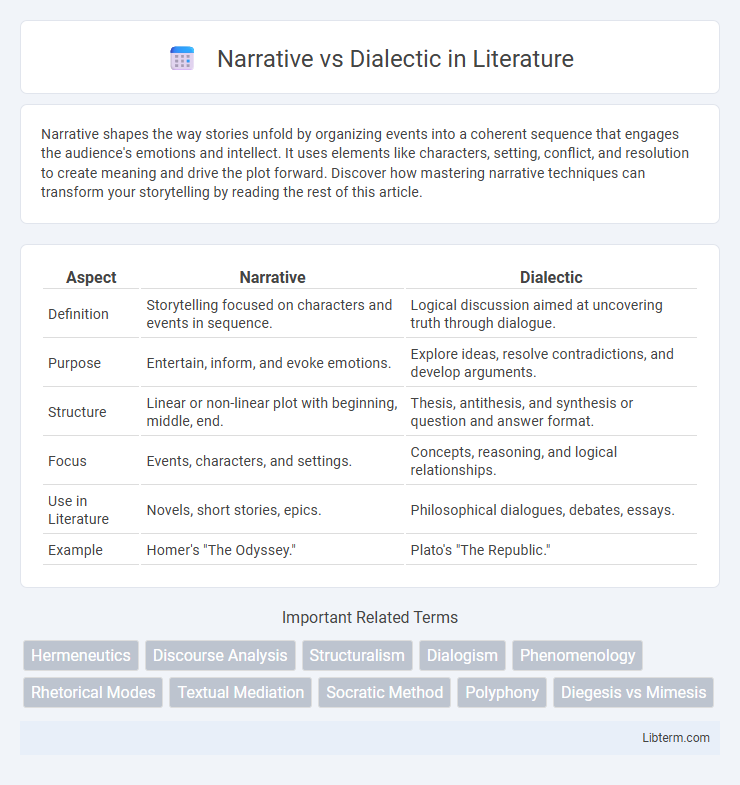Narrative shapes the way stories unfold by organizing events into a coherent sequence that engages the audience's emotions and intellect. It uses elements like characters, setting, conflict, and resolution to create meaning and drive the plot forward. Discover how mastering narrative techniques can transform your storytelling by reading the rest of this article.
Table of Comparison
| Aspect | Narrative | Dialectic |
|---|---|---|
| Definition | Storytelling focused on characters and events in sequence. | Logical discussion aimed at uncovering truth through dialogue. |
| Purpose | Entertain, inform, and evoke emotions. | Explore ideas, resolve contradictions, and develop arguments. |
| Structure | Linear or non-linear plot with beginning, middle, end. | Thesis, antithesis, and synthesis or question and answer format. |
| Focus | Events, characters, and settings. | Concepts, reasoning, and logical relationships. |
| Use in Literature | Novels, short stories, epics. | Philosophical dialogues, debates, essays. |
| Example | Homer's "The Odyssey." | Plato's "The Republic." |
Introduction to Narrative and Dialectic
Narrative involves storytelling that presents events and experiences in a structured, sequential manner to convey meaning and engage emotions. Dialectic emphasizes critical dialogue and logical reasoning to explore ideas, resolve contradictions, and reach higher understanding. Both approaches serve distinct cognitive and communicative functions in philosophy, literature, and pedagogy.
Defining Narrative: Structure and Purpose
Narrative is structured as a coherent sequence of events or experiences, organized to convey meaning and evoke emotional engagement. Its primary purpose is to construct a worldview or share knowledge through storytelling, enabling listeners to connect with the content on a personal level. Unlike dialectic, which seeks logical resolution through argumentation, narrative prioritizes experiential understanding and cultural transmission.
Understanding Dialectic: Principles and Process
Dialectic is a method of reasoning characterized by the structured exchange of arguments and counterarguments, aimed at uncovering truth through critical dialogue. Its principles include thesis, antithesis, and synthesis, facilitating the resolution of contradictions by integrating opposing viewpoints. The dialectic process involves continuous questioning, refinement of ideas, and collaborative exploration, promoting deeper understanding beyond mere narrative description.
Historical Origins of Narrative and Dialectic
Narrative origins trace back to ancient storytelling traditions, where oral histories and myths shaped cultural identity and preserved collective memory. Dialectic emerged in classical Greek philosophy, particularly with Socrates and Plato, emphasizing structured dialogue and logical argument to uncover truth. These foundational approaches distinctively influenced Western intellectual history by separating experiential storytelling from analytical reasoning.
Key Differences Between Narrative and Dialectic
Narrative emphasizes storytelling with a structured sequence of events aimed at conveying experiences or lessons, while dialectic engages in systematic dialogue to explore ideas through reasoned argumentation and counterargument. Narratives often rely on characters, plot, and perspective to evoke emotional responses, whereas dialectic prioritizes logical analysis and the synthesis of opposing viewpoints to reach conclusions. Key differences include narrative's focus on subjective interpretation and temporal flow, contrasting with dialectic's objective inquiry and hierarchical progression of thought.
Narrative Techniques vs. Dialectical Methods
Narrative techniques emphasize storytelling elements such as plot, character development, and thematic motifs to convey meaning and evoke emotional engagement. Dialectical methods focus on logical reasoning, thesis-antithesis-synthesis structures, and critical dialogue to explore contradictions and refine ideas. Effective communication leverages narrative's immersive qualities alongside dialectic's analytical rigor for comprehensive understanding.
The Role of Context: When to Use Narrative or Dialectic
Narrative excels in contexts where storytelling, personal experience, or culture sharing enhances understanding and engagement, making it ideal for education, marketing, and therapy. Dialectic proves effective in problem-solving, critical debates, and philosophical inquiries where reasoned argument and evidence evaluation are essential. Choosing between narrative and dialectic depends on goals: narrative shapes meaning through context and emotion, while dialectic drives clarity and truth through logical discourse.
Impact on Audience: Emotional vs. Rational Engagement
Narrative techniques engage audiences emotionally by creating vivid stories that evoke empathy, making complex issues relatable through personal experiences and vivid imagery. Dialectic approaches stimulate rational engagement, encouraging critical thinking and logical analysis by presenting contrasting ideas and evidence-based arguments. Choosing narrative or dialectic methods influences whether the audience connects through feelings or through intellectual reasoning.
Case Studies: Narrative and Dialectic in Action
Case studies effectively demonstrate the practical applications of narrative and dialectic methods, highlighting how storytelling structures complex information into relatable contexts while dialectic fosters critical thinking through systematic argumentation. In business, narrative case studies illustrate strategies and outcomes via sequential storytelling that appeals to human cognition, whereas dialectic case studies emphasize the exploration of conflicting viewpoints to reach reasoned conclusions. These contrasting approaches optimize understanding by balancing emotional engagement inherent in narratives with the analytical rigor promoted by dialectic techniques.
Conclusion: Integrating Narrative and Dialectic
Integrating narrative and dialectic enhances critical thinking by combining storytelling's emotional engagement with structured reasoning's logical analysis. This synergy allows for deeper understanding and more nuanced conclusions in complex discussions. Embracing both methods fosters balanced decision-making and effective communication across diverse contexts.
Narrative Infographic

 libterm.com
libterm.com